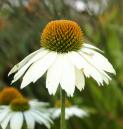264. Linum.—Linseed. Flaxseed.

 The ripe seed of Li'num usitatis'simum Linné, including not more than 3 per cent. of other harmless fruits, seeds or foreign matter.
The ripe seed of Li'num usitatis'simum Linné, including not more than 3 per cent. of other harmless fruits, seeds or foreign matter.
BOTANICAL CHARACTERISTICS.—The common flax is an annual; stem corymbosely branched at top. Leaves sessile, linear-lanceolate, smooth. Flowers in a corymbose panicle, with sky-blue petals. Pod about the size of a pea, of 5 united carpels (into which it splits in dehiscence), and 5-celled, with two seeds hanging from the summit of each cell, which is partly or completely divided into two by a false partition projecting from the back of the carpel, the pod thus becoming 10-celled.
HABITAT.—All temperate countries.
DESCRIPTION OF DRUG.—Oblong-ovate, flat, obliquely pointed at one end and blunt at the other. The brown, glossy, polished surface is seen, under the lens, to be marked with fine pits, and to be covered with a transparent mucilaginous epithelium that swells in water. The hilum occupies the slight hollow just below the apex. The embryo is oily, whitish, and inodorous. Taste mucilaginous, oily, and slightly bitter. Flaxseed meal is of a brownish-gray color, and has a slight odor.
Powder.—Characteristic elements: See Part iv, Chap. I, B.
CONSTITUENTS.—A viscid yellow fixed Oil, 30 to 35 per cent., proteids 25 per cent., resin, wax, a small quantity of amygdalin. The powder upon extraction with petroleum should yield not less than 30 per cent. of fixed oil, 98 per cent. of which should be saponifiable. An althaea-like mucilaginous substance resides in the epithelial layer, which swells considerably in water. This gummy matter from the investing coat is rapidly imparted to hot water, forming a thick, viscid mucilage, precipitated by alcohol and lead subacetate. The gummy principle is considered as transformed starch, which latter exists in the immature seed, but is absent in the ripe seed. Ash, not exceeding 6 per cent.
264a. OLEUM LINI.—A yellowish fixed oil expressed (for medicinal use) from the seed without heat, having a slight, pleasant odor, and a bland taste; on exposure to the air it gradually thickens and acquires a strong odor and taste. The oil used in the arts is obtained on a large scale by roasting the seeds before being pressed, in order to destroy the gummy constituents of the coating. It does not congeal above -20°C. (-4°F.). The most characteristic principle in the oil is linolein, C12H28O2, a glyceride of linoleic acid, and considered to be a mixture of two acids-linolic, C18H32O2, and linolenic acid, C18H30O2.The drying property of the oil resides in this constituent.
ACTION AND USES.—The whole seed is used in decoction as a demulcent; ground flaxseed is a favorite farina for poultices; the expressed oil is laxative, and, in combination with lime-water (Linimentum Calcis), is much employed as a protective in burns, etc.
OFFICIAL PREPARATION.
- From Oleum Lini.
- Linimentum Calcis (equal parts of linseed-oil and lime-water).

